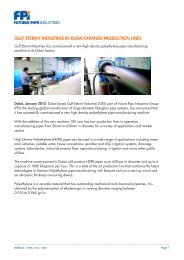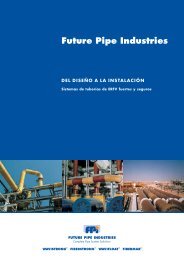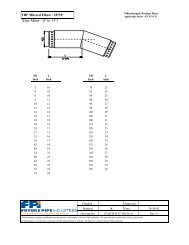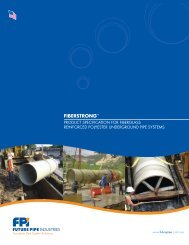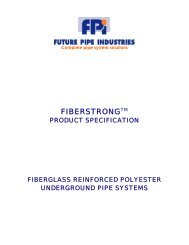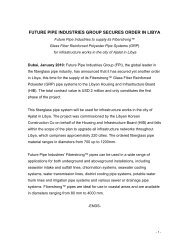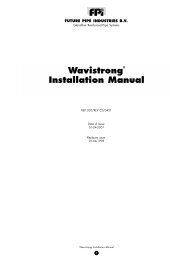Untitled - Future Pipe Industries
Untitled - Future Pipe Industries
Untitled - Future Pipe Industries
Create successful ePaper yourself
Turn your PDF publications into a flip-book with our unique Google optimized e-Paper software.
8.0: Repair and replacement of pipe<br />
The flow in the pipe section should be stopped by closing the appropriate valves in the system, or plugging the pipe ends<br />
and then draining the line.<br />
The replacement of a pipe or a fitting is similar to that of a closure (i.e., laying of the last length of pipe or fitting which closes<br />
or completes the line or a section of the line).<br />
To completely replace a damaged pipe, the couplings are first carefully removed by cutting them off with a circular blade<br />
saw. The pipe, and the rubber rings from the pipes adjacent to it, is then removed from its location in the line. Insert the new<br />
pipe as indicated below:<br />
• Carefully measure the gap where the replacement piece has to be fitted. The replacement piece must be well centered, and<br />
an equal clearance of 3/4” must be left between the inserted pipe and the adjacent ones.<br />
• Use a pipe on site with a constant OD, if necessary cut the pipe with a circular saw square to the end and bevel<br />
the pipe end with a grinding disk.<br />
• Pull the coupling into the pipe ends of the new pipe after abundantly lubricating the ends and the sealing rings. It will be<br />
necessary to gently help the second sealing ring over the chamfered (beveled) end of the pipe.<br />
• After cleaning them thoroughly, lubricate the ends of the two adjacent pipes well.<br />
• Insert the pipe in its final position and pull the coupling over the adjacent pipes up to the home line with the mechanical<br />
equipment described in section 5.2.<br />
To replace a damage pipe section<br />
• Carefully measure the gap where the replacement piece has to be fitted. The replacement piece must be 1 1/2” shorter<br />
than the length of the gap. The damaged section should be cut using a circular saw (taking care of electrical hazards when<br />
working in a wet trench).<br />
• Use a pipe on site with a constant OD, cut the pipe with a circular saw square to the end, to the required length and bevel<br />
the pipe end with a grinding disk. The new pipe section must be well centered, and an equal clearance of 3/4” must be<br />
left between the inserted pipe and the existing ones.<br />
• Pull the coupling into the pipe ends of the new pipe after abundantly lubricating the ends and the sealing rings. It will be<br />
necessary to gently help the second sealing ring over the chamfered (beveled) end of the pipe. After cleaning them thoroughly,<br />
lubricate the ends of the two adjacent pipes well.<br />
• Insert the pipe in its final position and pull the coupling over the adjacent pipes up to the home line with the mechanical<br />
equipment described in section 5.2.<br />
• Alternatively for sizes 16 through 64”, two standard ductile iron mechanical couplings may be used to join the new pipe<br />
sections. Care must be taken not to over-tighten the mechanical coupling bolts. Tighten enough to seal the joint and no more.<br />
42



